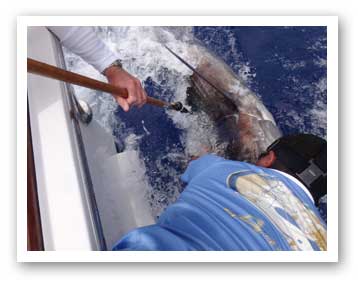
tag project news
The International Game Fish Association and Stanford University have partnered in a research program which combines the excitement of tournament angling with sophisticated billfish tracking.
Working with anglers and crews fishing at billfish tournaments around the world, the IGFA Great Marlin Race will deploy 50 electronic satellite tags on billfish in the Pacific, Atlantic and Indian Oceans over the course of a year.
Angling teams are invited to sponsor pop-up Archival Satellite Tags (PATs) to be placed on fish released during selected billfish tournaments. The tags automatically release themselves from the fish 120 days after deployment. Exact location of the tags is determined by earth-orbiting ARGOS satellites. For a given tournament, the tag that surfaces farthest from where it was initially deployed wins the “race” for that tournament.
Individual tournament “race” winners then wait until the 12 months of the Great Marlin Race have elapsed to see if their marlin will be the distance winner among all the fish tagged during the year.
The tags record depths, temperatures and light levels, data that helps scientists understand migration and behavior of billfish, and identify key habitat as well as the migratory corridors, in order to provide valuable guidance to fisheries managers.
“Pelagic fishes are under constant pressure from human exploitation,” explains Stanford University Professor of Marine Sciences Dr. Barbara Block, who pioneered the use of electronic tags on open ocean fishes in the early 1990s, and is one of the founders of the initial Great Marlin Race program. “As scientists our role is to provide resource policy makers with the best possible information about the life histories of these animals – so they can do a more effective job at managing their populations in the wild.”
The first IGFA Great Marlin Race kicked off in early September at the 58th International Billfish Tournament in San Juan, Purerto Rico. Angling teams sponsored 10 pop-up archival satellite tags valued at $4,000 and placed these in released Atlantic blue marlin during the tournament.
In 2009, a 140 -pound blue marlin traveled from Kona to the vicinity of the Marquesas Islands – a distance of 2,225 nautical miles. In 2010, this record was broken – when a 150-pound marlin swam 2,282 nautical miles east-southeast of Kona.
For information on the program contact IGFA Conservation Director Jason Schratwieser at jschratwieser@igfa.org.









